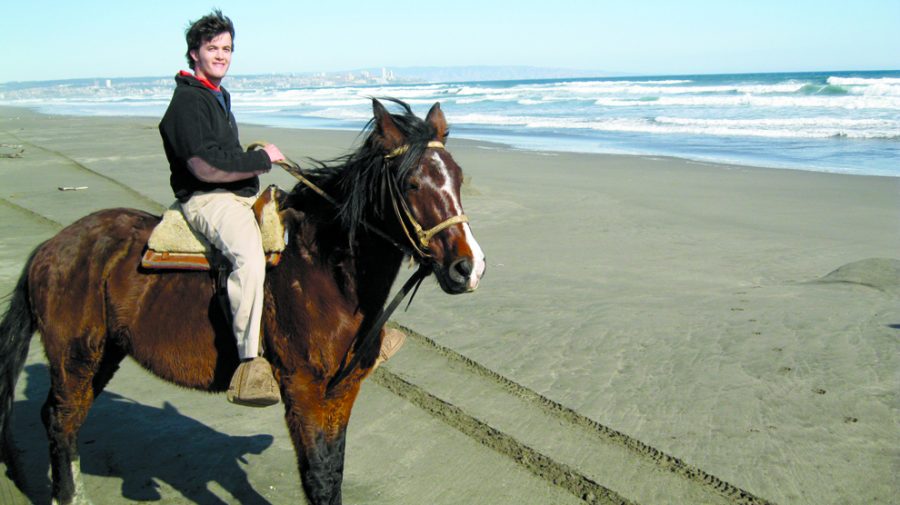I now know what inspired Patagonia Co.’s logo. At five in the morning, flying into Santiago, the purple, blue, black and orange mountains stamped on all the clothing company’s products appeared just out the airplane window. The Andes welcomed the plane to Chile.
It was an amazing sight, and Chile hasn’t let me down since. Especially living in the coastal metropolis of Valparaíso and Viña del Mar—two hours west of Santiago—the mountainous backdrop seems omnipresent. In the two cities, which sit in a manner reminiscent of Minneapolis and St. Paul, running together without clearly defined boundaries between each, the views are amazing. Since I live in Viña and have class in Valparaíso, each morning I take a bus down the main road immediately by the Pacific. Across the shallow bay Valparaíso utilizes for its shipping industry, the steep hills are completely covered with multicolored houses. Every morning it’s like a real-life Where’s Waldo picture of houses on the way to class, and it’s hard to miss something new every day.
Valparaíso, because of its convenient, central location on the Pacific in southwest South America, once served as a major shipping port for ships traveling around the Americas. Once they had passed through the dangerous Strait of Magellan, ships would stop in Valparaíso and recoup before the rest of their journey into the Pacific or up the coast. The opening of the Panama Canal, however, changed all of that—Valpo quickly became a had-been city, neglected and abandoned in many places.
Today, the city has essentially rebranded itself. Now, registered as a World Heritage Site, the city utilizes old, turn-of-the-century buildings for new enterprises—many of which deal with the arts. To someone from Alabama, it brings to mind images of Birmingham’s abandoned steel mills now used for new projects, like Sloss Furnace. The geography and city layout, though, are decidedly different than Birmingham. Bars and clubs line the streets that climb up from the waterline at fifty-degree angles up the steep hills. At night, the streetlights lining the roads look like orange veins on the hill from far away.
Intensely colorful graffiti lines literally every smooth vertical space in Valparaíso, and nearly every bit of it has a political twist of some sort. Politically, Chile is fascinating. The country remains only 20 years removed from the brutal dictatorship of Augusto Pinochet, who seized power in a bloody coup d’état backed by the Nixon administration and the CIA on September 11, 1973. The event occurred after Chile democratically elected their first Marxist president, Salvador Allende—the first time in the world, in fact, that a Marxist won a democratic presidential election. Allende remains a muse to many of the grafitti artists in Valparaíso.
I mention all that to say that those events weigh heavily on the collective Chilean conscience. Many Chileans are intensely liberal from an American point of view, despite the huge prevalence of Catholicism. My “cultura” class professor is Marxist, and my host brother is communist, for example. All this makes my experience doubly interesting as an American, or “gringo,” in this environment.
Ultimately, I’ll remember Chile as one of the most fascinating places I’ve ever been, and not just from an intellectual standpoint. Chile is just fun, too.
I’ve gone to a four-story club and ridden horses on the beach and across 150-foot sand dunes at Ritoque. I’ve had tea with the Chilean Constitution Commissioner’s assistant in the Chilean National Congress building and toured the chambers of Chile’s upper and lower houses with him. I’ve eaten shrimp and scallop empanadas in the tiny hippie fishing village of Horcón to the north. I’ve played guitar with a street performer on the curb in Valparaíso and experienced what was supposedly a magnitude-four earthquake from the 10th floor of a 10-story building. I’ve watched more “fútbol” than I ever thought I would—¡Viva Chile! —and had the time of my life for the past three weeks.
I’m just now nearing the halfway mark of my trip. Now, with a growing collection of Chilean friends and a few new American friends—including Molly Barret and Froy Batsielilit from the University – I only look forward to the next three weeks against the backdrop of the Andes.









